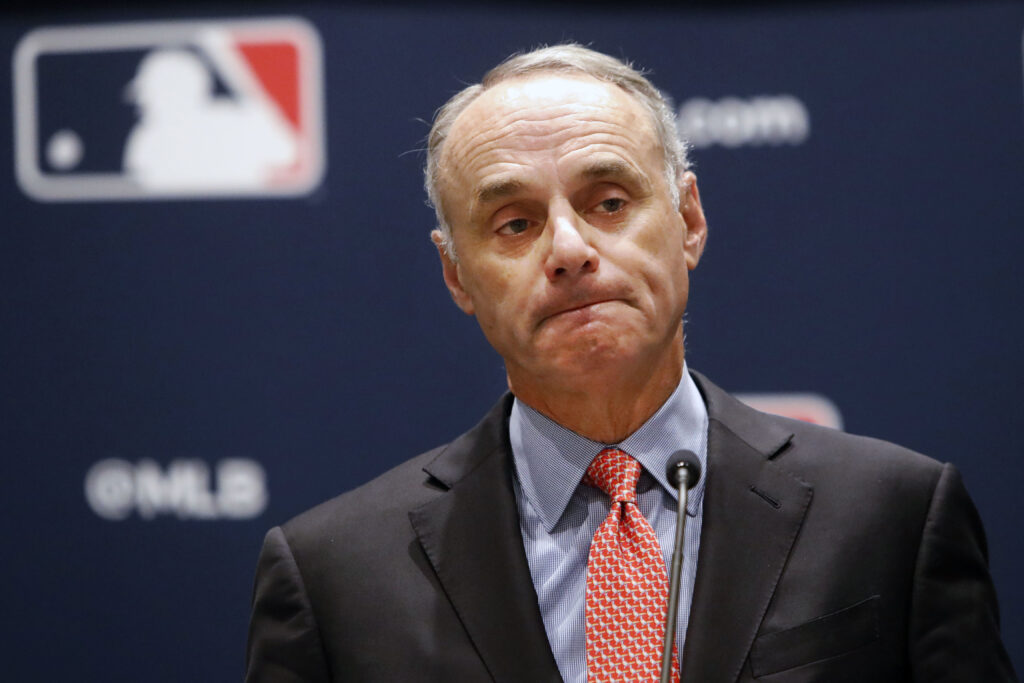MLB Commissioner Rob Manfred likes to think of himself as a “glass-half-full” person. While the league has made positive strides under his tenure, mainly by shortening games and making them more exciting, the glass of “America’s Pastime” is tilting empty due to various off-the-field issues.
Professional baseball, which is declining in sporting relevance in this country, is unlikely to see an uptick towards a fuller glass anytime soon, unless a miracle happens in Manfred’s final four years in charge to improve the issues plaguing the business side of the league.
Manfred has undeniably improved MLB’s watchability by implementing rule changes that shorten game times. The introduction of a pitch clock has reduced downtime between pitches, and the league is currently testing an Automated Ball-Strike System (ABS) in Spring Training to enhance umpire accuracy at home plate.
However, the state of the sport off the field is in dire straits from ongoing stadium drama and a growing television rights issue, started by numerous teams losing their regional television contracts.
Manfred’s predecessor Bud Selig successfully oversaw an MLB ballpark bonanza. Around two dozen teams unveiled new ballparks between 1995 and 2005. The Baltimore Orioles’ Oriole Park at Camden Yards and the San Francisco Giants’ Oracle Park immediately became must-visit attractions and exemplary ideals for what a modern sports stadium should look like.
On the other hand, Manfred has completely mishandled oversight of teams’ stadium situations, most notably involving the Athletics and the Tampa Bay Rays. This year, the Athletics and the Tampa Bay Rays will play their home games at minor-league ballparks, an ill-afforded but partially avoidable scenario that will only further stain the sport’s reputation.
The A’s will spend the next three seasons playing in the Triple-A Sacramento River Cats’ stadium before moving to Las Vegas. Rather than extend their lease at the Oakland Coliseum, owner John Fisher chose a rent-free move, prioritizing cost-cutting over fan loyalty.
Meanwhile, MLB owners unanimously approved the relocation, despite Oakland’s dedicated fanbase pleading for a sale to someone willing to keep the team ‘Rooted in
Oakland.’ The hypocrisy is clear—while Manfred and other owners now urge Rays owner Stuart Sternberg to sell, they ignored years of A’s fans demanding the same of Fisher.
Rather than fight to keep the A’s in the Bay Area—a large market that has supported multiple teams for the past half-century—Manfred has aided in their departure.
Another reason why the sport is decaying is fewer people are interested in or able to watch baseball on their television screens. Both the stadium and television dilemmas indicate that this historic league is still lagging behind when it comes to modernization.
Regional television coverage separates MLB from the NFL and NBA. After opting out of MLB’s deal with ESPN (RIP Sunday Night Baseball), the league’s media rights look to drastically change in the years to come. Manfred’s big idea is a national streaming package through which fans could watch any or all of the games.
While details are scarce and the plan is still a few years away, one thing is certain: the cost to watch baseball will increase. Additionally, good luck getting the New York Yankees and Los Angeles Dodgers to give up their lucrative local media deals.
Sports fan Stewart Falso offered his advice for what MLB should do to match the success of other leagues.
“I believe the root of this comes down to the watchability of baseball in comparison to other sports leagues,” Falso said via phone. “In the past few years, new leagues have been created based around the fan / viewer experience, rather than the sport. Two examples are the Premier Lacrosse League, and the TGL. Both took existing leagues and sports, and made them more fun to watch to fans, landing them higher viewership numbers. This includes increased camera angles, mic’d up players, and exciting social media…I believe the MLB should focus on the fan experience more, which could mean implementing live mics during games, more creative TV angles & shots, and creating a more fun atmosphere that focuses on the fan.”
MLB needs to figure out its stadium and media issues to get fans back in their seats or else the first sport America embraced will be an afterthought.


